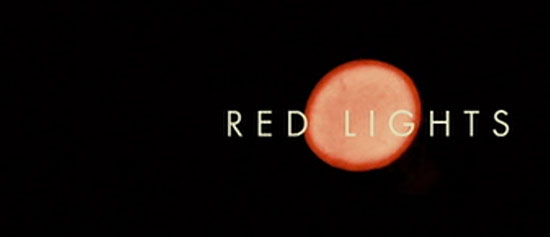
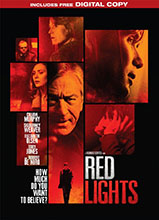 BUY FROM AMAZON: CLICK HERE!
BUY FROM AMAZON: CLICK HERE!
MSRP $28.99
RATED R
STUDIO Millennium
RUNNING TIME 113 Minutes
SPECIAL FEATURES
• Cast Interviews
• Director’s Interview
• Making-Of Featurette
• Behind the Scenes
The Pitch
It’s like somebody tried to make a contemporary companion piece to The Prestige, but went totally off the rails.
The Humans
Cillian Murphy, Sigourney Weaver, Elizabeth Olsen, Toby Jones, Robert De Niro
The Nutshell
Veteran paranormal researchers Dr. Margaret Matheson (Sigourney Weaver) and Tom Buckley (Cillian Murphy) debunk fraudulent claims of ghost whispering, faith healing and other psychic phenomena by detecting what Matheson calls red lights, the subtle tricks behind every staged supernatural occurrence. But when the legendary blind psychic Simon Silver (Robert De Niro) comes out of retirement after 30 years, his once-fearless adversary Matheson warns Buckley to back off, fearing reprisal from the powerful Silver. Determined to discredit Silver, Buckley and his star student (Elizabeth Olsen) use every tool at their disposal to uncover the truth behind the charismatic mentalist.
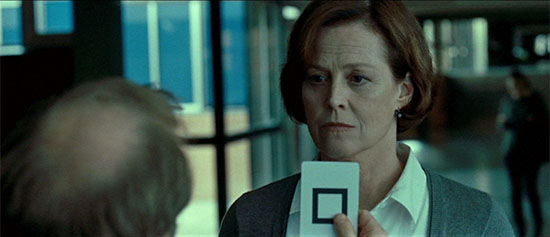
“My, Dr. Venkman. How you’ve shrunk.”
The Lowdown
All good stories need truth. I’m not saying that all good stories must be true, but there must be a feeling of truth, that we’re seeing things unfold in a truthful manner. Context is everything. If characters say or do silly things against the backdrop of, say, Middle Earth, it’s easier to get away with a lot. But if your characters are saying and doing very silly things against the backdrop of a recognizable, contemporary setting, then you run a much higher risk of everything smelling like bullshit.
“But Travis,” you say, “this is a movie. It’s fantasy, anyway. Why does it even matter?”
It matters because good stories create a world in which you can invest, emotionally and intellectually. Even the most far-out, wacky, lose-touch-with-reality movies, like 2001: A Space Odyssey (or more recently, Only God Forgives) manage to feel real, at least, unto themselves.
Settings are approximations of places, real or imaginary. This is where storytellers have an immense amount of liberty. If your setting doesn’t feel real, your characters can still provide a foundation in which audiences can invest. Characters (even inhuman ones) are approximations of people. Dialogue is an approximation of how people talk. The actions of characters are approximations of what people might do, given the circumstances. These are rules of storytelling. They can be bent and broken, but doing so puts you at risk of distancing your audience.
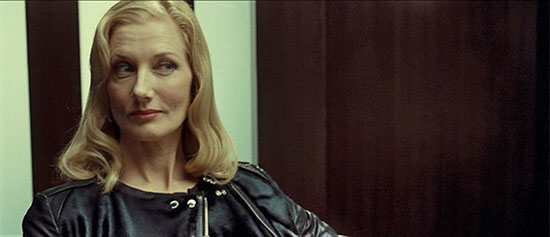
If that glance was any more sideways it would star Paul Giamatti.
As you may have guessed, this is the main problem with Red Lights, which was written, directed, and edited by Buried director Rodrigo Cortés. The premise itself is not the issue, it’s that our film takes place in an anachronistic setting (the film appears to take place in the seventies until Weaver whips out her Macbook Pro) that doesn’t feel real, the dialogue never sounds real, and the actions of the characters don’t feel real.
It’s a shame, because Cortés is a very strong visual filmmaker, and they cast the hell out of this movie. Cillian Murphy is as strong a lead here as he was in 28 Days Later, and he shares great chemistry with Elizabeth Olsen, the film’s underused romantic interest. Sigourney Weaver’s James Randi-esque debunker and Toby Jones’ nebbishy professor round out the cast very nicely, and there’s even a great ice queen part for Joely Richardson. Submarine lead Craig Roberts has a small role as a college student with a shaky American accent.
“But wait,” you say, “isn’t Robert De Niro in this, too?”
Yeah, he’s in it. It is, hands down, his worst performance in a long time. I love De Niro, but he’s egregiously miscast as a Uri Geller-type rockstar mentalist. The character’s dialogue is so awful that De Niro doesn’t seem to want to deliver it. The film attempts to build him up as an intimidating nemesis, but whenever he appears on screen it all just fizzles and sputters. The film does him no favors by casting Grand Piano director Eugenio Mira as a young Simon Silver in a flashback montage. Mira may look the part, but is no better than a hammy impersonator, aping De Niro’s persona, but not recreating the character. Mira’s lines were dubbed over by De Niro or a soundalike, but it’s a moment that is so exquisitely awful that it grabs you by the collar and shakes you.
It’s decisions like that one that begin to shred any sense of truth in a story. Or like when the apparently blind Simon Silver steps off a private jet, removes his sunglasses to reveal his cataracts to us, and then replaces his sunglasses. It’s a small moment that is designed to tell the audience that Silver is blind, without using any dialogue. Using dialogue to explain that to the audience would have been too expository. But why would a blind guy visibly remove his glasses all the way when stepping into the sunlight, just to put them back on a moment later? It feels totally inorganic. Instead, you might have seen another character leading Silver down the stairs, or perhaps Silver using a cane. Later, a police officer, of a team of police officers, ready to help our sham-sniffing duo bust a faith healer, asks Matheson, “Doctor, how come you’re so sure this guy’s a fraud?” Not only is this question asked, but it’s asked inside the theater, right before the faith healer walks on stage. Evidently, faith healing is a crime in this reality, and it takes three skeptics, a room full of gadgets, and a whole cadre of police officers to send a faith healer to prison. Ludicrous.
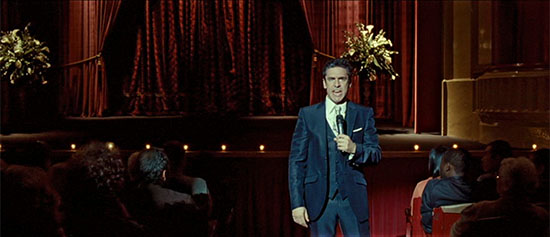
Volatile emcee says: “We’re coming to you live from FUCK! SHIT!.”
The ending, while I won’t tell you exactly what transpires, simply reaffirms what I suspected all along about Red Lights: you can’t stick the landing if you haven’t been adequately preparing for it. It also violates another big rule about storytelling: this is a visual medium. Don’t tell when you can show. If you need a voiceover to explain what the hell just happened in your movie, then you failed to display the action in a manner that is clear and engaging.
What is ever more frustrating about Red Lights is that it shows promise. I love the color palette of the film. Victor Reyes’ score is lyrical and big. The dynamic between Matheson and Buckley is like buddy cops (Weaver actually says “I’m getting too old for this shit” to Buckley), but there’s also an obvious mother-son thing happening, with Matheson’s real son in a coma and Buckley’s mother long dead. What sucks is that the dynamic completely disappears less that halfway through the film, leaving us dangling.
Olsen is fantastic, and her character is set up as another sharp-minded skeptic, but she might as well be a window washer because her skills have very little relevance later in the film. Craig Roberts’ character has more responsibilities, and should have been cut during preproduction, allowing Olsen to actually DO SOMETHING instead of just being Buckley’s girlfriend.
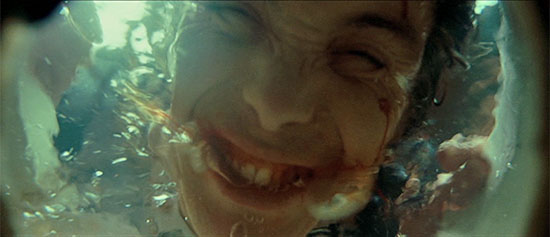
Smile for the shitter, Murphy!
I will say this: there’s a fight scene in a bathroom near the end of the film that is extremely well staged, well shot, and positively brutal. Just like in Buried, Cortés shows promise when you shove in him a small box and let him figure it out, but the larger scope of Red Lights collapses due to a fundamental lack of truth in the setting, the characters, their actions, and their dialogue. How strange that a film whose core theme is about cutting through the bullshit should come off so fake.
The Package
Things aren’t so good in the presentation department, either. The transfer is so dark that I had to heavily brighten all the screenshots I took, just so you guys could see what was going on. The sharpness isn’t great either, and colors tend to bleed into one another. Luckily, the 5.1 Surround audio track is much better.
The extras are okay, but only just. The cast interviews are skippable, since it’s basically everyone complementing one another. The director’s interview is better, as is the Making-Of featurette, which features some footage repeated from the interviews. The behind-the-scenes featurette is just a couple of minutes of b-roll footage from the set, which is the kind of fly-on-the-wall stuff I like to watch. It’s so short, though, that it may not have been worth including.
Rating: 




Out of a Possible 5 Stars